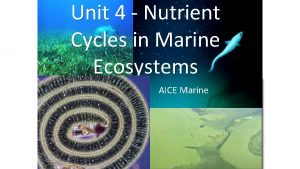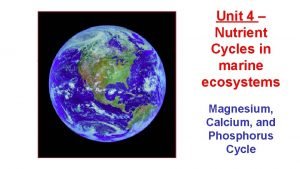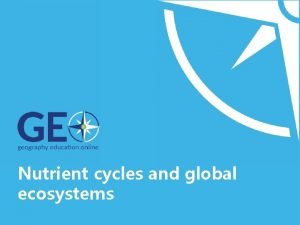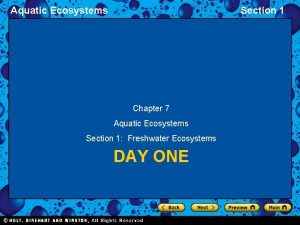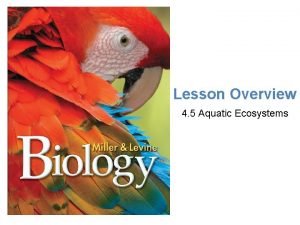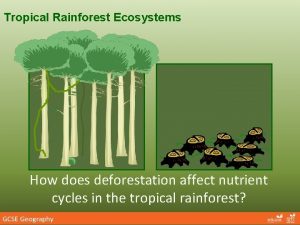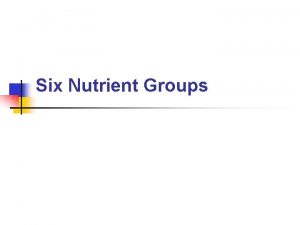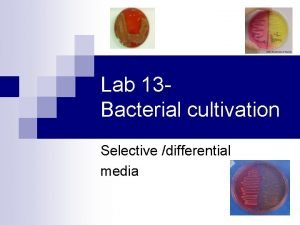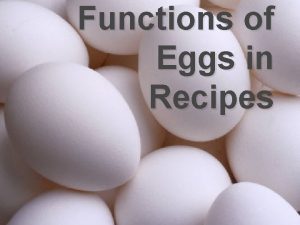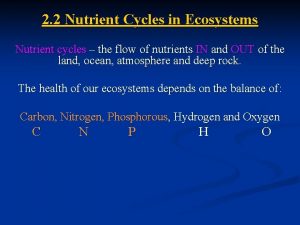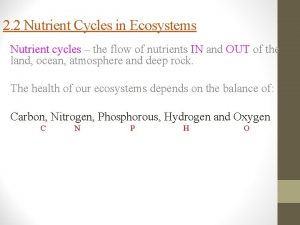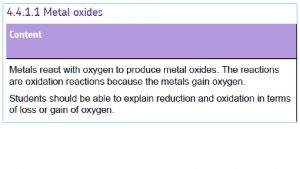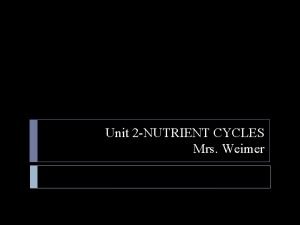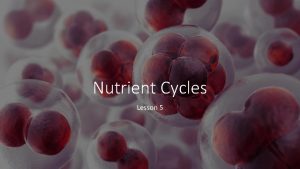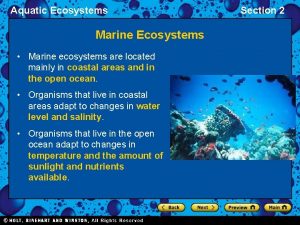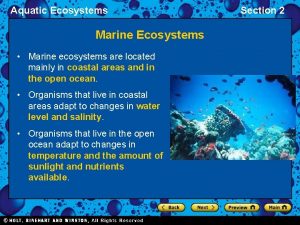Unit 4 Nutrient Cycles in marine ecosystems Magnesium











- Slides: 11

Unit 4 – Nutrient Cycles in marine ecosystems Magnesium, Calcium, and Phosphorus Cycle

Magnesium: • Used to make chlorophyll

Ca Cycle: • Ca present in ocean as Ca 2+ (calcium ions) • From weathering/erosion of rocks; brought to ocean from runoff of rivers • Used by marine organisms to: – Make corals – Make shells (mussels, clams, scallops, etc)—Ca. CO 3 – Make bone—Ca. CO 3 • Fall to seabed when organisms die • Forms limestone (AKA Calcium Carbonate Ca. CO 3)/chalk

Calcium Cycle: = Ca. CO 3 **“Quick lime” = calcium oxide **Slaking: mix w/ H 2 O


The Phosphorous Cycle • Biological uses: used to make DNA and bone • Very slow process • Found only in sedimentary rocks and water (not in atmosphere) • Released as rocks erode • Travels through food chain • Released by decomposition

The Phosphorus Cycle Phosphorus occurs only in very minute amounts in the atmosphere. The main reservoirs of phosphorus are rock (especially the mineral apatite) and natural phosphate deposits, from which the element is released by weathering, leaching, erosion, and mining for agricultural use. Some of the phosphorus passes through terrestrial and aquatic ecosystems as organic phosphorus from plants to grazers, predators, and parasites. It is returned to the ecosystem by excretion, death and decay. In terrestrial ecosystems, organic phosphates are reduced by bacteria to inorganic phosphates.

The Phosphorus Cycle The global phosphorus cycle is unique among the major biogeochemical cycles in having no significant atmospheric component Human impacts on the global phosphorus cycle • Phosphorus fertilizers used in agriculture are derived from phosphate rock. Most of the phosphate fertilizer combines with calcium, iron, and ammonium in soil to form insoluble salts and little escapes in runoff. • Part of the phosphorus used as fertilizer is removed in crops, transported far from the point of application and eventually released as waste in the processing and consumption of food. • Phosphorus is concentrated in wastes from food processing plants, feedlots, and sewage plants. • Most of the phosphorus enrichment of aquatic ecosystems comes from sewage disposal plants. • Overenrichment or eutrophication of freshwater ecosystems (where phosphorus is usually limiting) even more of a problem with phosphorus than with nitrogen.


• The Phosphorus Cycle The phosphorus cycle in terrestrial and aquatic ecosystems.

Crash Course: Nitrogen & Phosphorus http: //youtu. be/le. Hy-Y_8 n. Rs
 Nutrient cycles in marine ecosystems
Nutrient cycles in marine ecosystems Marine magnesium cycle
Marine magnesium cycle Peptone water
Peptone water Biogeochemical cycles apes
Biogeochemical cycles apes Gersmehl cycle
Gersmehl cycle What two locations are marine ecosystems usually located?
What two locations are marine ecosystems usually located? Photic and aphotic zones
Photic and aphotic zones A. profunda brachii
A. profunda brachii Nutrient cycle of a tropical rainforest
Nutrient cycle of a tropical rainforest Nnn plant protein
Nnn plant protein Differential media
Differential media Eggs as a binding agent
Eggs as a binding agent
